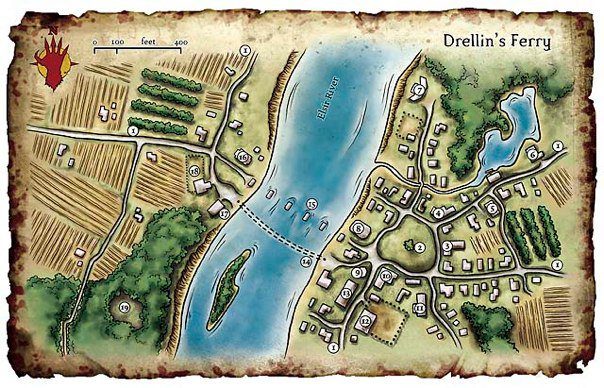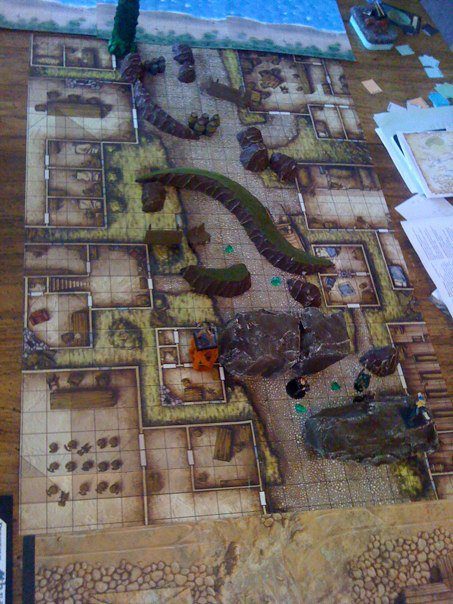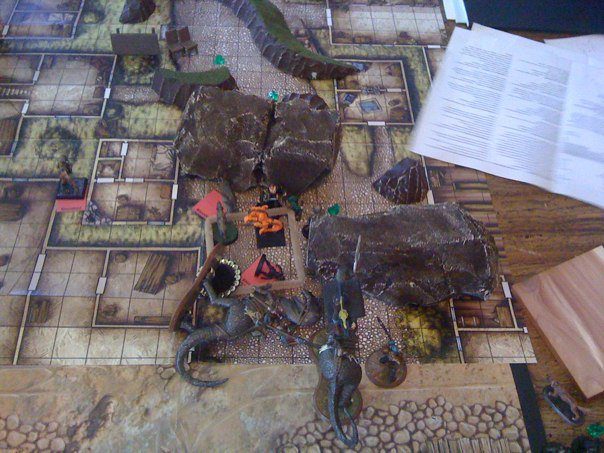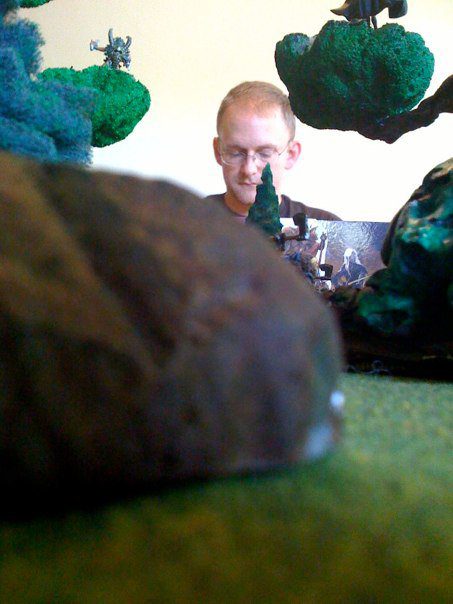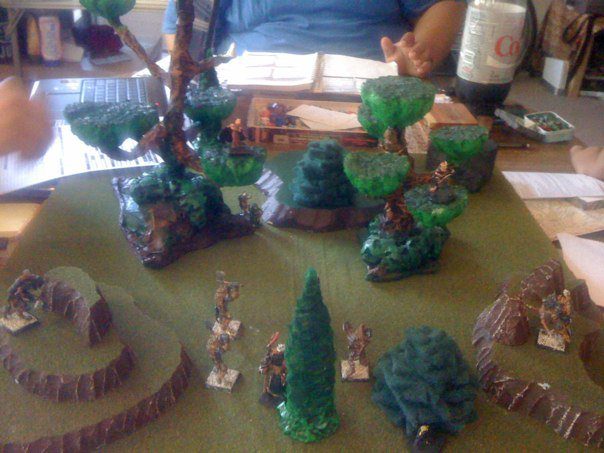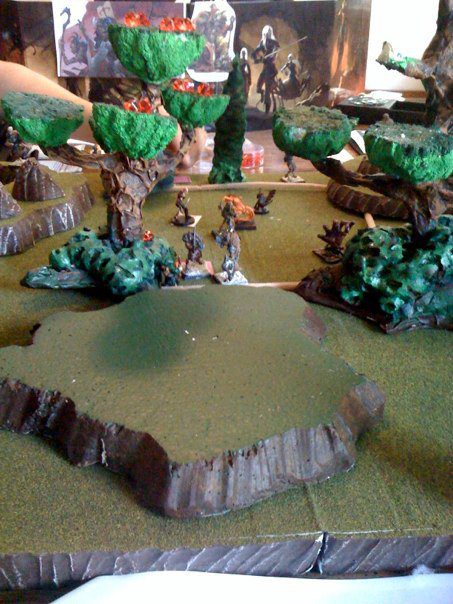In Defense of Skill Challenges
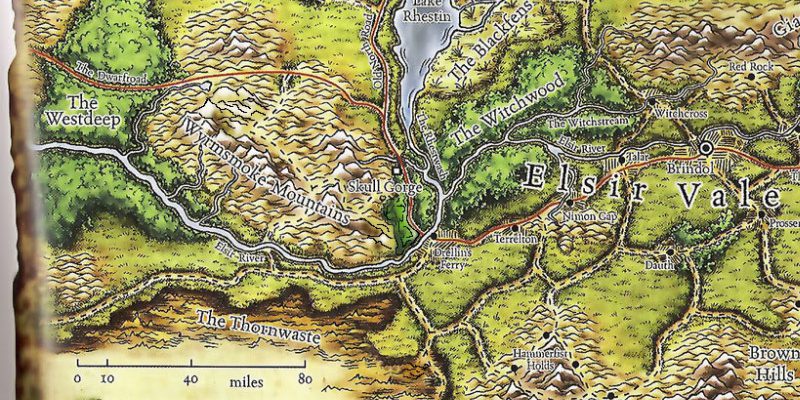
This article was referenced recently on the Talking TableTop podcast and originally appeared on www.gameschangelives.com. I’ve overhauled the original 4th ed version for 5th edition to showcase the many ways skills, tool kits, spells, and even backgrounds can be used to encourage a cooperative and narrative non-combat chase scene.
A common complaint about 4th edition DnD was that it reduced all roleplaying opportunities to skill checks via the Skill Challenge mechanic. We all know you should never let a game tell you that you can’t roleplay, but I understand where the concern comes from because I felt the same way. Mechanics should encourage roleplaying, not stifle it. As I believe you can’t truly understand a mechanic until you get it on the table, I folded a skill challenge into my 4th ed game. What I discovered was that when properly used, skill challenges enhanced roleplaying while keeping high-stress non-combat situations stressful.
I’ve never used skill challenges for important social interactions, like swaying a council to heed a warning about an oncoming horde, in the same way I’d never let a single Diplomacy [5th edition: Charisma (Persuasion)] check persuade them, but physical challenges like chase scenes and social interactions with less important PCs became much more interesting.
SPOILER ALERT: If you plan on running/playing Red Hand of Doom, by Rich Baker and James Jacobs, this post makes reference to an event that occurs at the end of Part 1. Red Hand of Doom is one of the best written sandbox-style modules for DnD v3.5. If you haven’t run it, you should.
Below is an example of a skill challenge I constructed for the 3rd ed module, “Red Hand of Doom“, which I converted to 4th edition [5th edition: see the end of the article for the detailed 5th ed version] In this scene, the players are escaping the burning town of Drellin’s Ferry as its being overrun by a horde they can’t possibly stop. In the module, the scene is vaguely described (something like, ‘as the PCs escape from the burning town, they must evade patrols’), but this skill challenge allowed the stress of the chase to build and gave the players multiple options if they succeeded.
In fairness to those having issues with skill challenges as written, I use a new mechanic and a house rule to fine-tune my challenges.
Group Check: The Group Check is a type of Aid and is described under Stealth (Group) below. Group checks prevent a single bad roll from messing up the entire party, while allowing unskilled party members to slow down someone with crazy skills. Group checks represent skilled members giving less skilled members guidance during a non-combat situation, particularly when used with Stealth-, Nature-, and Perception-style checks. Having players roll group checks one at a time also adds to the suspense.
5th edition: This is less of an issue in 5th ed. Group checks in 5th are designed so that if at least half the party members succeed, the group succeeds. This represents the more skilled members of the group helping the less skilled ones.
House Rule: Players cannot attempt the same skill check twice in a row, they must describe how they are using a skill, and they cannot use the same description twice. This prevents players saying “I make a Nature [5th edition: Wisdom (Survival) or Intelligence (Nature)] check to navigate the burning trees” six times in a row. You can use that description once (though I encourage more interesting use of the skill). If you want to use Nature again, you must think of something else. In the case of my PCs, one player used a Nature check to read the fire and winds. They ran through an area of dense smoke to hide their scent from the pursuing gnolls. Even if a skill is ‘passive’ like Perception, Stealth, or Insight, the player making the check should describe the scene based on the check results. This creates brilliant cooperative storytelling opportunities.
It’s also important to note that the players were only aware of what primary skills would be helpful, while being clear that any skill was fair game as long as they could come up with a reasonable use for it. They were not told the specific mechanics except that they needed 10 successes before 3 failures and that Stealth (Group) checks must gain them 2 of the successes. As several of the PCs had poor Stealth checks, this increased the anxiety from the start. [5th edition: I’ve changed this to 2 group Stealth checks, and 1 group Athletics or Acrobatics checks to increase the tension and potentially damaging consequences.]
The players in my game barely escaped with 10 successes to 2 failures. They would have lost with 3 but one of the players used Intimidate [5th edition: Charisma (Intimidate)] to terrify a gnoll scout into not revealing their location, negating one of their failures. Because they succeeded, they had the choice of either escaping, or ambushing Wyrmlord Koth in the woods outside of town. They chose ambush.
To increase player interaction, I gave them a variety of set pieces and allowed them to build the area where the ambush would take place. I then placed Koth’s forces and the players were allowed to place their minis anywhere on the board after I’d placed the villains. They were given a full round of surprise and Combat Advantage [5th edition: I give the players a full round before rolling initiative as they are likely to be low on HP, HD, and spells by the time this ambush happens.]. Between the adrenaline rush of the skill challenge, cooperative storytelling behind the chase scene, and an intense combat encounter, the session was a huge success.
TL;DR: If you have a deep-seated hatred of skill challenges, I encourage you to look again, not to replace roleplaying, but to stimulate the imaginations of your players and encourage cooperative storytelling. I found them to be a powerful tool in my DM’s toolbox and will be using them again whatever edition I play.
For more photos and conversion ideas for Red Hand of Doom, check out my photo gallery of the campaign.
Escape From Drellin’s Ferry Skill Challenge
5th edition Skill Challenge
The PC’s must escape the burning town and countryside around Drellin’s Ferry while being hunted by the red dragon Abrithiax, Wyrmlord Koth, and packs of Gnolls.
Before the challenge starts, let the players know the target successes (10 before 3 failures), the primary skills (Survival, plus group Stealth, Acrobatics, and Athletics), and the minimum requirements (2 Stealth successes and 1 Acrobatics or Athletics success). You can also advise them that the use of other ability checks, such as Perception or Insight, may grant either successes or unique advantages.
Setup: The PC’s start the challenge with ½ hit points, 1/2 Hit Dice, and 1/2 spell slots per spell level (rounded down). They must navigate the burning town and countryside of Drellin’s Ferry to either escape, or ambush Wyrmlord Koth.
Complexity: 10 successes before 3 failures. Ability check DCs equal 15 unless otherwise noted.
Special Rewards: At 6 successes, the party is allowed to take a short rest. At 10 successes, they gain Inspiration.
Backgrounds: If your PCs have appropriate background features, such as the Outlander’s grasp of terrain, feel free to give the player advantage on one or more skill checks depending on how they describe the use of a skill.
Spells as Successes: If PCs wish to use spells in place of an ability check to gain successes, they may gain 1 success, or 1 success and 1 failure depending on the spell. Obvious area effect spells (fireball to blow through a collapsed building or attack a gnoll pack, ice wall to block pursuers, entangle to hinder pursuit) grant both a success and a failure, as large area spells draw attention from pursuers outside the spells effects. Target spells (ray of frost, acid arrow, etc) may grant one success if described well. I suggest limiting the total successes from spells to 2 or 3, just to keep the immediacy of the action on the players’ actions. If you have a party that’s spellcaster heavy, you might allow them 4-5 spell successes.
Exploration-pillar spells can be very helpful in this challenge. Pass without trace for example grants the party +10 on their stealth checks, all but guaranteeing up to 4 successes. Invisibility used on a player with a low Stealth check may allow them to skip participating in the group check. Keep in mind that ability checks cannot be made back-to-back, so a spell like pass without trace that requires concentration or that has a time limit may be disrupted by the success or failure of other checks.
Skills and Tools
Players are allowed to come up with any appropriate use of skills or tool kits to use during this challenge. They may use the same skill more than once, but 1) may not make them back-to-back, and 2) they must describe how the skill is used differently each time. At least 2 successes must be gained through group Dexterity (Stealth) checks, and 1 success must be gained through either a group Strength (Athletics) or a group Dexterity (Acrobatics) checks.
Primary ability checks grant successes. Secondary ability checks grant bonuses to primary checks or other advantages. These are examples only. You should encourage your group to describe this chase scene in as dramatic and interesting a way as possible by rewarding innovative roleplaying.
Primary Ability checks
Dexterity (Stealth) (group, DC 17); Strength (Athletics) (group); Dexterity (Acrobatics) (group); Wisdom (Survival); Intelligence (Nature)
Stealth (Group): A failed group Dexterity (Stealth) checks result in 2 longbow attacks against the lowest rolling PCs (+6 to hit, 1d10+4 (10) piercing damage) in addition to the failure. Special: At least 2 (no more than 4) of the successes for this challenge must be Dexterity (Stealth) checks.
Athletics/Acrobatics: Example: PCs navigate treacherous paths through the rubble and fire. A failed group check results in the lowest rolling PC taking damage in addition to the failure [2d6 (7) fire, bludgeoning, slashing, or piercing, or whatever you feel meets the needs of your game]. Special: At least 1 (no more than 3) of the successes for this challenge must be from either a group Strength (Athletics) or Dexterity (Acrobatics) check.
Survival/Nature: Example: A PC scouts a path through the raging fire and smoke, finds a way to disguise the groups’ scent, or leads their pursuers through hazardous terrain. On a failed check, a random PC takes damage in addition to the failure [1d6 (4) fire, bludgeoning, slashing, or piercing, or whatever you feel meets the needs of your game].
Secondary Ability checks
Charisma (Deception or Intimidate) (DC 17); Thieve’s Tools; Mason’s Tools; Tinker’s Tools; Wisdom (Insight or Perception)
Deception/Intimidate: Example: PC discovers a way to throw off their pursuers or persuade them to think twice about following. These checks do not add successes, but instead remove a single failure. They may only be used once each during the challenge.
Thieve’s/Mason’s/Tinker’s Tools: Example: PC sets up a trap, opens a locked door into a non-burning building, finds a weak spot in a stone building, etc, to grant the group a breather. A successful check allows the party to take a short rest. Each short rest after the first also grants a failure as the horde overruns the city, increasing the possibility the PCs are found.
Insight/Perception: Example: PC uses his skills to predict when and where the hunters will move, or see their pursuers before the pursuers see them. These checks grant advantage on any single check depending on how the scene is described.
Skill Challenge Success!: If the PCs accumulate 10 successes before 3 failures, they may escape Drellin’s Ferry, ambush Wyrmlord Koth’s group, or offer another advantage.
Ambush Layout:
1) Provide the players with 3D terrain pieces to layout the forest area where they want the ambush.
2) DM then places Wyrmlord Koth’s party anywhere in the play area (not within 3-6″ of the edge depending on map size).
3) Players place their minis anywhere in the play area.
4) PCs gain a full round of surprise (move, action, and bonus action if applicable)
Skill Challenge Failure!: If the PCs hit 3 failures before 10 successes, they are trapped by Koth and his men.
1) Provide a city map, or place 3D terrain pieces in a forested area just outside of town. The party will likely be trapped in a building or in a clearing.
2) Allow the players to place their PCs anywhere within a specific location. For example, in or on a building, or anywhere in the center of a forest map (not within 3-6″ of the map edge depending on the map’s size).
3) Place the villains anywhere on the board that is not open to the players (within 3-6″ of the map edge, or outside of the building).
4) Koth and his gnolls gain initiative on the first round of combat. Roll normally for the second round.
Skill Challenge Tie!: It is possible to hit 10 successes and 3 failures at the same time (via spells). If that happens, you can either consider it a success, or have the players remain trapped in the city unfound. Koth may think the PCs have escaped when they haven’t. This option isn’t covered in the module so you’ll have to ad lib the results.
(Original) Escape From Drellin’s Ferry Skill Challenge
4th edition Skill Challenge
Rich Howard
The PC’s must escape the burning town and countryside around Drellin’s Ferry while being hunted by the red dragon Abrithiax, Wyrmlord Koth and packs of Gnolls.
Setup: The PC’s start the challenge at ½ Healing Surges (rounded up), ¾ HPs, 0 AP, and are down 1 daily and 2 encounter powers. They must navigate the burning town and countryside of Drellin’s Ferry to either escape, or ambush, Wyrmlord Koth.
Level: 10 (DC: 14, 19, 23)
Complexity: 10 successes before 3 failures
Special Rewards: At 4/8/10 successes, each PC regains a single healing surge. At 6 successes, they are allowed to take a short rest. At 10 successes, they gain an Action Point.
Use of Spells: If PCs attempt to use spells in place of a skill check, they may gain a success, or both a success and a failure depending on the spell. Area/Burst/Blast spells gain both a success and a failure. Single Target spells gain a success but may only gain 2 successes total during the challenge.
For example, Treybur wants to use the Chill Wind At-Will power to put out a fire in the PCs way. The fire is put out, gaining a success, but the area affect attack draws the attention of nearby gnoll patrols, gaining a failure.
Primary Skills: Stealth (group, 23); Athletics/Acrobatics (19); Streetwise/Nature (19)
Stealth (Group): One PC makes Stealth check. All other PC’s must Aid. Those who are aiding make rolls as follows: 15+ = +2 to primary Stealth Check; 10-14 = +0 to primary Stealth check; 9 or less = -2 to primary Stealth check. Failed Stealth check results in 2 longbow attacks against randomly determined PCs (+10 vs AC, 1d10+4 dmg) in addition to the failure. At least 2 of the successes for the challenge must be Stealth checks.
Athletics/Acrobatics: PC tries to navigate a treacherous path through the rubble and fire. On a failed check, the PC loses 1 healing surge in addition to the failure.
Streetwise/Nature: PC leads the party through the burning trees and buildings.
Secondary Skills: Bluff (14); Intimidate (14); Thievery (19); Insight/Perception (14)
Bluff/Intimidate: PC discovers a way to throw off their pursuers or persuade them to think twice about following. These skills do not add successes, but instead remove a single failure. They may only be used once each during the challenge.
Thievery: PC sets up a trap, opens a locked door into a non-burning building, etc, to allow the group a breather. In addition to adding a success, the PCs regain a single healing surge.
Insight/Perception: PC uses his skills to predict when and where the hunters will move, or see their pursuers before the pursuers see them. These skills don’t provide successes/failures, but do add a +2/-2 to any single check made by themselves or an ally.
Success: If the PCs accumulate 10 successes before 3 failures, they may either escape Drellin’s Ferry or ambush Wyrmlord Koth’s group.
Ambush Layout:
1) Provide the players with 3D terrain pieces to layout the forest area where they want the ambush.
2) DM then places Wyrmlord Koth’s party anywhere in the play area designed by the PCs
3) Players then place their minis anywhere in the play area.
4) PCs gain a full round of surprise (move, action, and bonus action if applicable)
Failure: If the PCs hit 3 failures before 10 successes, they are trapped by Koth and his men.
1) Provide a city map, or place 3D terrain pieces in a forested area just outside of town. The party will likely be trapped in a building or in a clearing.
2) Allow the players to place their PCs anywhere within a specific location. For example, in or on a building, or anywhere in the center of a forest map (not within 3-6″ of the map edge depending on the map’s size).
3) Place the villains anywhere on the board that is not open to the players (within 3-6″ of the map edge, or outside of the building).
4) Koth and his gnolls gain initiative on the first round of combat. Roll normally for the second round.

